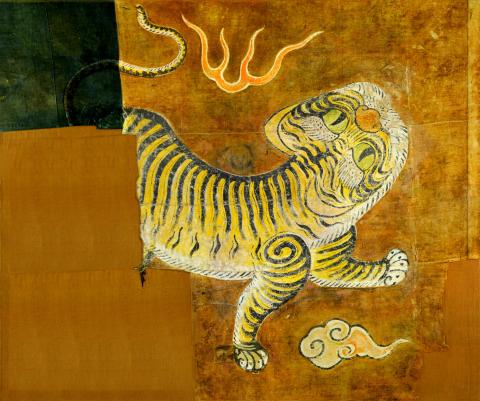When members of Taiwan’s elite declared independence as a move to halt Japan’s takeover of the country towards the end of the 19th century, one of the first things they designed was a flag to reinforce their determination to be free from imperial rule. A replica of the original flag, known as the Yellow Tiger Flag (黃虎旗) of the Republic of Formosa (台灣民主國), is currently on display at the National Taiwan Museum.
The museum’s curators said that the Yellow Tiger Flag embodied the aspirations of the pro-independence forces in Taiwan, which was ceded to Japan in the 1895 Treaty of Shimonoseki following China’s defeat in the First Sino-Japanese War.
Despite high hopes and fierce resistance, however, these anti-Japanese fighters only held out for five months before being overwhelmed by Japanese forces. The flag, having been captured, was immediately sent to Japan.

Photo courtesy of the National Taiwan Museum
The National Taiwan Museum, which holds a replica of the original flag painted in 1909 by Japanese artist Untei Takahashi, recently discovered documents that yield a greater understanding about the thinking that went into the design of original flag, the whereabouts of which remain unknown.
“We organized the exhibition so as to share our findings following extensive restoration, which took 15 months to finish,” Li Tzu-ning (李子寧), an associate curator at the museum, told Taipei Times in an e-mail interview.
The museum’s staff found that the tiger drawn on the back of the flag is different from the tiger drawn on the front. Though the overall features of the two felines look the same, there are minor variations.
“The pupils of the tiger on the front are round and open, while the ones at the back are crescent-shaped. This shows that the pupils dilate and contrast in response to the amount of light in the day and at night,” said Wu Pai-lu (吳百祿), a researcher who took part in the repair project.
“The two tigers, one posing for the day and the other for the night, create an image that is both symmetrical and complementary. It coincides with the belief that the flag will protect the nation day and night (日夜護國),” he said.
Though Takahashi’s work is only a facsimile, Wu says it’s “crucially important” because the original flag — or three flags according to some historical documents — is nowhere to be found.
Of the four existing duplicates in Taiwan, the Takahashi version is the only one that was commissioned and approved by the then-Japanese authorities. In 1953, Chiu Nien-tai (丘念台) — the son of Chiu Feng-jia (丘逢甲), the man who led the resistance against Japan’s occupation — commissioned respected artist Lin Yu-shan (林玉山) to create two paintings based on Takahashi’s flag. Lin produced another color ink version of the flag in 1974.
Although it continues to serve as a symbol of Taiwan’s autonomy, Lee said that today’s independence activists are disinclined to use the flag because of its complex associations with the past.
“The main reason is because the Republic of Formosa was so short-lived,” he said. “And, declaring independence was a diplomatic strategy” to return Taiwan to China.

Most heroes are remembered for the battles they fought. Taiwan’s Black Bat Squadron is remembered for flying into Chinese airspace 838 times between 1953 and 1967, and for the 148 men whose sacrifice bought the intelligence that kept Taiwan secure. Two-thirds of the squadron died carrying out missions most people wouldn’t learn about for another 40 years. The squadron lost 15 aircraft and 148 crew members over those 14 years, making it the deadliest unit in Taiwan’s military history by casualty rate. They flew at night, often at low altitudes, straight into some of the most heavily defended airspace in Asia.

Many people in Taiwan first learned about universal basic income (UBI) — the idea that the government should provide regular, no-strings-attached payments to each citizen — in 2019. While seeking the Democratic nomination for the 2020 US presidential election, Andrew Yang, a politician of Taiwanese descent, said that, if elected, he’d institute a UBI of US$1,000 per month to “get the economic boot off of people’s throats, allowing them to lift their heads up, breathe, and get excited for the future.” His campaign petered out, but the concept of UBI hasn’t gone away. Throughout the industrialized world, there are fears that

Like much in the world today, theater has experienced major disruptions over the six years since COVID-19. The pandemic, the war in Ukraine and social media have created a new normal of geopolitical and information uncertainty, and the performing arts are not immune to these effects. “Ten years ago people wanted to come to the theater to engage with important issues, but now the Internet allows them to engage with those issues powerfully and immediately,” said Faith Tan, programming director of the Esplanade in Singapore, speaking last week in Japan. “One reaction to unpredictability has been a renewed emphasis on

Taiwan’s democracy is at risk. Be very alarmed. This is not a drill. The current constitutional crisis progressed slowly, then suddenly. Political tensions, partisan hostility and emotions are all running high right when cool heads and calm negotiation are most needed. Oxford defines brinkmanship as: “The art or practice of pursuing a dangerous policy to the limits of safety before stopping, especially in politics.” It says the term comes from a quote from a 1956 Cold War interview with then-American Secretary of State John Foster Dulles, when he said: ‘The ability to get to the verge without getting into the war is